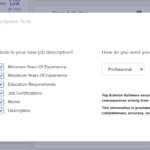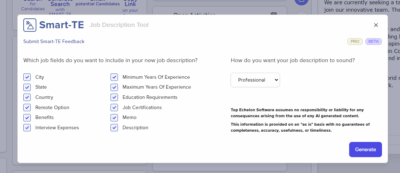In the recruiting profession, timing, precision, and effective communication are more critical than ever. Recruiters must not only identify top talent quickly but also engage them in ways that encourage participation and build meaningful connections. Candidates are often fielding multiple offers, and a delay or poorly executed communication can mean the difference between securing the ideal candidate or losing them to a competitor. This is why using multiple communication channels is so vital to success.
Gone are the days when sending mass emails to potential candidates was enough. Modern recruiting requires a strategic, multi-channel approach that leverages various communication methods—such as email, SMS texting, video calls, and calendar invites—to reach and engage candidates in personalized and impactful ways. With recruiting software making it easier to manage these channels, recruiters can now create seamless communication strategies that maximize efficiency and boost engagement.
In this article from Top Echelon Recruiting Software, we will provide an in-depth exploration of the key communication channels used in recruitment today and offer best practices for how recruiters can use them to enhance candidate engagement and optimize their placement strategies.
1. Email: The Workhorse of Recruitment Communication
Email remains the backbone of professional communication in recruiting. Despite the rise of other tools, email continues to play a crucial role in reaching candidates at every stage of the recruitment process. Whether sending out job postings, interview confirmations, or offer letters, email is one of the most reliable channels for formal communication.
Mass Emails: Casting a Wide Net
Mass emailing is often used when recruiters need to reach a large pool of candidates quickly. By sending the same message to multiple recipients, recruiters can efficiently announce open positions or share company updates. While mass emails can save time, they come with a significant drawback: their impersonal nature. Candidates often feel like they are one of many, which can reduce engagement rates.
The solution to this problem lies in email automation and personalization. Modern applicant tracking systems (ATS) and customer relationship management (recruitment CRM) tools allow recruiters to customize mass emails with candidate-specific details, such as their name, job title, or previous interactions. This personalized touch can make a mass email feel more engaging and improve the likelihood of candidate response.
For example, when a candidate applies for a position, a personalized email can automatically be sent to confirm receipt of their application and provide next steps in the process. By automating such tasks, recruiters can maintain professional communication without sacrificing the personal touch.
Email Personalization and Automation: Key to Success
Email automation tools allow recruiters to send out personalized messages at scale, ensuring that communication is both timely and relevant. For instance, when candidates reach specific milestones—such as scheduling an interview or completing a job application—automated emails can acknowledge their progress and keep them informed.
Automation tools also provide opportunities for recruiters to set up follow-up emails at regular intervals. If a candidate has applied for a position but hasn’t responded to an initial outreach, automated reminders can be sent without requiring manual intervention. This keeps the recruitment process moving efficiently while also showing candidates that their application is being considered.
Best Practices for Email Communication
- Segmentation: Organize your email lists by criteria such as candidate experience, industry, or job location. By segmenting your audience, you can send targeted messages that resonate more deeply with specific groups of candidates.
- Craft Clear Subject Lines: Subject lines should be clear, concise, and engaging. Candidates are more likely to open emails with subject lines that prompt curiosity or action. Examples include “Exciting Job Opportunity in [Industry]” or “Your Next Career Move Awaits.”
- Include a Strong Call to Action (CTA): Every email should end with a clear CTA. This might be a link to schedule an interview, a button to confirm availability, or an invitation to submit additional materials. Make it easy for candidates to take the next step.
- Follow-Up Strategies: Set up follow-up email sequences that check in with candidates who haven’t responded to your initial outreach. Make sure these follow-ups are spaced appropriately to avoid spamming candidates while ensuring continued engagement.
By refining email communication strategies with automation, segmentation, and personalization, recruiters can create stronger, more engaging relationships with candidates and improve overall response rates.
2. SMS Texting: Quick, Direct, and Personal
As mobile phones have become ubiquitous, SMS texting has emerged as one of the most effective communication tools for recruiters. With job seekers frequently on the move, SMS offers a direct line to candidates, allowing recruiters to reach them in real-time. Research shows that 73% of job seekers prefer receiving job-related information via SMS, making it a crucial channel in any recruitment strategy.
The Power of SMS in Recruitment
What makes SMS so powerful is its immediacy. Unlike emails, which can sit unopened for hours or even days, text messages are typically read within minutes. For recruiters, this means that SMS is the ideal tool for time-sensitive communications, such as interview scheduling, reminders, or quick updates on the candidate’s status.
Another major advantage of SMS is its high open rate. Studies show that SMS messages have an open rate of nearly 98%, compared to an average email open rate of around 20%. This makes SMS particularly effective for critical communication that requires a quick response.
Integrating SMS with ATS Platforms
Many modern ATS platforms offer built-in SMS capabilities, allowing recruiters to send and receive text messages directly from the system. This integration offers several key benefits:
- Centralized Communication: By keeping all communication—whether through email, SMS, or phone—within one system, recruiters can easily track interactions with candidates and ensure no messages fall through the cracks.
- Automation and Scheduling: Similar to emails, SMS messages can be automated and scheduled based on specific triggers, such as confirming an interview or sending reminders the day before.
- Maintaining Professional Boundaries: Using an applicant tracking system for SMS ensures that recruiters can maintain a professional boundary, as texts are sent from a company number rather than a personal phone number.
Best Practices for SMS Communication
- Stay Professional: While texting is often a more casual medium, it’s important to maintain a professional tone. Avoid slang, keep messages concise, and use proper grammar.
- Use SMS for Essentials: SMS is best used for quick, essential updates, such as confirming interview times or sending reminders. For longer conversations or sensitive topics, email or phone calls are more appropriate.
- Identify Yourself: Always start by introducing yourself and your organization. A simple “Hi [Candidate’s Name], this is [Your Name] from [Your Company]” goes a long way in establishing trust and clarity.
- Respect Candidates’ Time: Avoid sending SMS messages outside of standard business hours unless absolutely necessary. Respecting candidates’ time demonstrates professionalism and can prevent negative impressions.
By adhering to these best practices, recruiters can harness the power of SMS to foster stronger candidate engagement, improve communication efficiency, and ensure a smooth recruiting process.
3. Video Calling: Building Personal Connections in a Virtual World
As remote work becomes more commonplace, video calling has become an essential tool for recruiters. Platforms such as Zoom, Google Meet, and Microsoft Teams have allowed recruiters to connect with candidates around the world without the need for in-person meetings.
Why Video Calls Are Effective in Recruitment
Video calls provide a unique opportunity to build personal connections with candidates that email and SMS simply cannot. Through video, recruiters can assess a candidate’s body language, facial expressions, and overall demeanor—critical factors that are difficult to gauge through text alone.
For candidates, video calls offer the chance to make a stronger impression. Not only can they showcase their communication skills, but they can also demonstrate professionalism and adaptability, which are important traits in today’s work environment. Video calls are particularly useful during the early stages of the recruitment process, as they allow recruiters to screen a higher volume of candidates efficiently.
Setting Up for a Successful Video Call
Conducting a video call requires preparation to ensure the candidate experience is smooth and professional. Any technical difficulties or distractions during the call can reflect poorly on both the recruiter and the organization.
- Choose a Neutral, Professional Background: Avoid distractions in the background by opting for a neutral, clean environment. Some video platforms offer virtual backgrounds if your surroundings aren’t suitable for a professional call.
- Position Your Camera Properly: The camera should be at eye level to simulate natural eye contact. Looking directly into the camera creates a more engaging and authentic interaction.
- Test Your Equipment: Ensure that your microphone, camera, and internet connection are working properly before the call. A poorly executed video call with technical issues can disrupt the conversation and negatively impact the candidate’s perception.
- Maintain Professionalism: Dress as you would for an in-person meeting and avoid distractions during the call. The candidate’s experience should be as professional and polished as possible.
Leveraging Video for Assessment and Collaboration
Video calls aren’t just about building personal connections—they can also be used as powerful assessment tools. Many companies now use video interviews as an initial screening step to evaluate a candidate’s fit before moving them through the recruitment pipeline. Additionally, recorded video calls can be shared with hiring managers or other team members, adding an extra layer of collaboration in the decision-making process.
By adopting video calling as a core part of their recruitment strategy, recruiters can build stronger connections with candidates while streamlining the interview process.
4. Calendar Invites: Simplifying the Scheduling Process
One of the most challenging aspects of recruitment is coordinating schedules between candidates, hiring managers, and interview panels. With multiple stakeholders involved, scheduling interviews can quickly become a logistical nightmare. Calendar invites can significantly simplify the process by ensuring all parties are aligned and kept up to date on interview logistics.
Why Calendar Invites Are Important
Calendar invites provide candidates with a clear, organized way to confirm interview times, dates, and locations (whether virtual or in-person). By sending calendar invites through an ATS or email, recruiters can ensure that candidates have all the necessary information in one place, reducing the risk of scheduling conflicts or miscommunication.
Using ATS Integration for Scheduling
Many ATS platforms now offer built-in calendar synchronization tools that allow recruiters to automate the scheduling process. This means that when a candidate selects a time for their interview, an automatic invite is sent to both the candidate and the interviewer(s). ATS tools also provide automated reminders to reduce the risk of no-shows or last-minute cancellations.
Best Practices for Calendar Invites
- Send Invites as Early as Possible: Once an interview is confirmed, send the invite immediately to give candidates plenty of time to prepare.
- Provide All Relevant Details: The invite should include not only the time and date of the interview but also the names of the interviewers, the meeting format (in-person or virtual), and any materials the candidate should prepare.
- Follow Up with a Confirmation Email: While calendar invites are essential, a follow-up email is a good practice to reiterate the interview details and provide a direct line of contact in case changes need to be made.
By simplifying the scheduling process with calendar invites, recruiters can minimize logistical challenges, reduce the risk of miscommunication, and ensure that interviews run smoothly.
Mastering Multi-Channel Communication in Recruitment
In recruitment, effective communication is key to engaging candidates and making successful placements. By leveraging a variety of communication channels—including email, SMS, video calls, and calendar invites—recruiters can create a multi-faceted communication strategy that caters to the preferences and needs of individual candidates.
Each communication method offers its own strengths, and by using them in combination, recruiters can create a more personalized and efficient recruitment process. With the help of modern recruiting software, these channels can be automated and integrated, allowing recruiters to focus on building relationships rather than administrative tasks.
By following the best practices outlined in this guide, recruiters can not only improve their communication strategies, but also enhance the overall candidate experience—leading to better engagement, higher response rates, and ultimately, more successful placements.









